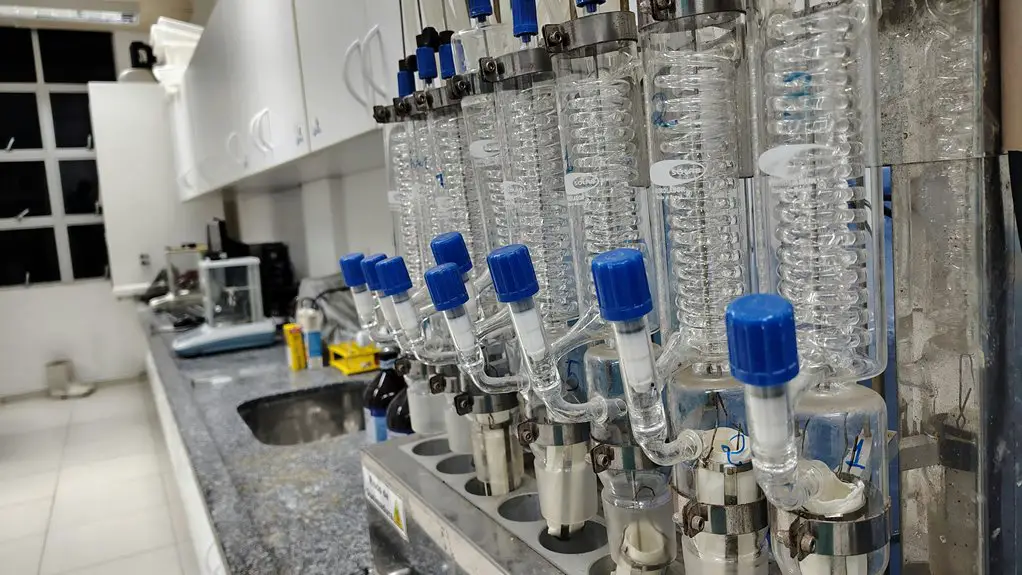You’ll find polyamide stronger than polyester mainly because of its molecular structure. Polyamide’s chains form strong hydrogen bonds, creating a tough, tightly-knit network that resists stretching and wear. Polyester has fewer bond sites, so while it’s chemically stable, it doesn’t match polyamide’s durability or heat resistance. This makes polyamide the go-to for demanding uses where strength matters. Keep exploring, and you’ll uncover more about what sets these materials apart.
Table of Contents
Key Takeaways
- Polyamide’s strong hydrogen bonds create a robust molecular network, enhancing tensile strength beyond that of polyester.
- The amide linkages in polyamide enable superior chain rigidity and durability compared to polyester’s ester-based backbone.
- Polyamide’s crystalline structure and hydrogen bonding confer higher thermal stability, resisting heat better than polyester.
- Polyamide shows greater abrasion resistance and less surface wear, maintaining strength and appearance longer than polyester.
- Polyester lacks hydrogen bonding, resulting in lower mechanical strength and thermal resistance compared to polyamide’s tougher molecular framework.
Molecular Structure of Polyamide
Polyamide’s molecular structure features repeating units linked by amide bonds, which give the material its strength and flexibility.
When you look closer, these amide bonds form strong hydrogen bonds between polymer chains, creating a stable network. This network resists stretching and tearing, so polyamide fibers hold up well under stress.
You’ll also notice the chains arrange themselves in a way that balances rigidity with some mobility, letting the material bend without breaking. This unique structure makes polyamide more durable compared to many other polymers.
As you handle polyamide fabrics, their resilience largely comes from these molecular interactions, which help maintain shape and resist wear.
Understanding this structure helps you see why polyamide performs better in demanding applications.
Molecular Structure of Polyester
You’ll notice that polyester’s molecular structure features a strong polymer backbone made of repeating ester groups.
This setup gives the chains flexibility and impressive strength, affecting how the fabric performs.
Plus, its crystallinity plays a key role in defining its thermal properties and durability.
Polyester Polymer Backbone
Understanding the polyester polymer backbone helps you grasp why this material is so versatile and durable.
Polyester’s backbone consists of repeating ester functional groups (-COO-) linked between aromatic or aliphatic rings. This structure forms through a condensation reaction between diacids and diols, creating long chains with strong covalent bonds. The ester linkages provide chemical stability, resisting degradation from acids, bases, and moisture.
You’ll notice that the backbone’s regularity allows for tight packing, which contributes to polyester’s toughness. However, unlike polyamides, polyester’s backbone lacks hydrogen bonding sites, which influences its overall mechanical properties.
The balance between rigidity from the aromatic units and flexibility from the ester bonds makes polyester suitable for various applications, from fabrics to packaging materials, while maintaining resilience and resistance to environmental factors.
Chain Flexibility and Strength
Although polyester’s backbone offers chemical stability, its chain flexibility and strength play an essential role in determining its performance in various applications. You’ll find that the ester linkages in polyester chains allow moderate flexibility but less than polyamides. This impacts tensile strength and elongation, influencing durability and comfort in fabrics.
| Property | Polyester | Impact on Performance |
|---|---|---|
| Chain Flexibility | Moderate | Balanced stiffness |
| Tensile Strength | High | Durable under tension |
| Elongation | Moderate | Some stretchability |
| Chemical Stability | Excellent | Resistant to degradation |
Understanding these aspects helps you appreciate why polyester suits many uses but may fall short compared to polyamide in strength-critical roles.
Crystallinity and Thermal Properties
Polyester’s crystallinity plays an essential role in its thermal behavior and overall performance. When you look at its molecular structure, the regular arrangement of chains allows regions of high crystallinity, which enhances strength and heat resistance.
The more crystalline the polyester, the higher its melting point, meaning it can withstand greater temperatures before deforming. However, the amorphous regions provide flexibility, balancing rigidity and toughness.
You’ll also notice that increased crystallinity improves dimensional stability and resistance to solvents. But remember, polyester’s crystallinity is generally lower than polyamide’s, which partly explains why polyamide often exhibits superior mechanical and thermal properties.
Understanding these differences helps you appreciate why polyester suits applications needing moderate heat resistance and durability without sacrificing flexibility.
Hydrogen Bonding in Polyamide
Hydrogen bonding plays an essential role in defining the physical properties of polyamide fibers.
When you look closely, polyamide’s structure contains amide groups that form strong hydrogen bonds between polymer chains. These bonds act like molecular bridges, holding chains tightly together. Because of this, you get enhanced tensile strength and durability in polyamide materials.
You’ll also notice that these hydrogen bonds contribute to polyamide’s high melting point and resistance to deformation under stress. Unlike weaker intermolecular forces, hydrogen bonds provide a network of connections that resist stretching and breaking.
Chemical Bonds and Strength in Polyester
When you examine polyester, you’ll find that its strength primarily comes from ester linkages connecting the polymer chains. These ester bonds form through a reaction between carboxylic acid and alcohol groups, creating a stable but somewhat flexible connection.
Unlike the strong hydrogen bonds in polyamide, polyester’s ester bonds are covalent but don’t facilitate extensive intermolecular bonding. This means the chains can slide past each other more easily, which influences the material’s tensile strength.
You’ll notice polyester has a balance of durability and flexibility, but its chemical bonds don’t create as robust a network as polyamide’s amide linkages.
Impact of Polymer Chains on Durability
When you look at durability, polymer chain length plays an essential role in how well fibers hold up over time.
Stronger molecular bonds within these chains also boost resistance to wear and tear.
Understanding these factors helps you see why some fabrics last longer than others.
Polymer Chain Length
Although polymer chain length isn’t always obvious, it plays an essential role in determining the durability of polyamide and polyester fibers.
When you look at polyamide, you’ll find its chains are typically longer and more linear than those in polyester. These extended chains allow the molecules to align closely, creating a more cohesive and robust fiber structure.
In contrast, polyester’s shorter chains don’t pack as tightly, which can lead to weaker mechanical properties. Longer polymer chains in polyamide also mean fewer chain ends, reducing weak points where fibers might break under stress.
Molecular Bond Strength
Understanding polymer chain length sets the stage for examining how molecular bond strength affects the durability of polyamide and polyester.
You’ll find that polyamide’s chains connect through strong hydrogen bonds, creating a tougher, more resilient structure. These bonds act like molecular glue, holding the chains firmly together and resisting wear and tear.
Polyester, on the other hand, relies mainly on weaker van der Waals forces between chains, making it less resistant to stretching and abrasion.
When you choose polyamide, you’re picking a material with stronger intermolecular forces, which translates to better durability and longevity.
Resistance to Wear and Tear
Since you rely on fabrics to last through daily use, knowing how polyamide and polyester handle wear and tear matters.
Polyamide, commonly known as nylon, boasts superior abrasion resistance. This means it withstands friction and rubbing better than polyester, making it less prone to pilling and surface damage. When you choose polyamide, your garments or gear maintain their smooth, intact appearance longer, even under frequent stress.
Polyester, while durable, is more susceptible to surface wear and may develop fuzziness with extended use. So, if your activities demand tough, resilient fabric that holds up against constant contact, polyamide is the smarter choice.
Its molecular structure lends it toughness that directly translates to enhanced resistance against the daily grind, ensuring your items stay functional and looking good for longer.
Thermal Stability Differences
When you expose polyamide and polyester to heat, their thermal stability behaves quite differently.
Polyamide, or nylon, can withstand higher temperatures before breaking down, thanks to its strong hydrogen bonds and crystalline structure. This means it maintains its strength and shape better under heat.
Polyamide’s strong hydrogen bonds and crystalline structure let it resist heat and keep its shape longer.
Polyester, on the other hand, has a lower melting point and starts to soften sooner because its molecular chains are less tightly packed. If you heat polyester excessively, it can deform or lose integrity faster than polyamide.
So, when you need a material that endures higher temperatures without degrading, polyamide often outperforms polyester.
Understanding these thermal stability differences helps you choose the right fabric for heat exposure, ensuring durability and performance in demanding conditions.
Applications Benefiting From Polyamide’s Strength
Polyamide’s ability to maintain strength at higher temperatures opens the door to many practical uses.
When you choose polyamide, you’re getting a material that holds up well under stress and heat, making it ideal for demanding environments.
You’ll find its strength benefits these key applications:
- Automotive parts, where durability and heat resistance are essential
- Outdoor gear and sportswear that face rough conditions
- Industrial machinery components requiring wear resistance
- Electrical insulation, benefiting from thermal stability and toughness
Frequently Asked Questions
How Do Environmental Factors Affect Polyamide and Polyester Degradation?
Imagine sunlight and moisture as tiny sculptors shaping your fabric’s fate. You’ll find polyamide weakens under UV rays, while polyester resists better. But both degrade faster in harsh heat and humidity, so protect them wisely.
What Are the Recycling Processes for Polyamide and Polyester?
You can recycle polyamide through chemical depolymerization or mechanical recycling, while polyester often undergoes mechanical recycling or chemical recycling like glycolysis. Both processes recover fibers, reducing waste and allowing you to reuse materials efficiently.
Are There Any Health Concerns Associated With Polyamide or Polyester Fabrics?
Imagine wearing a fabric that traps heat or irritates your skin—polyamide and polyester can sometimes cause allergies or discomfort. You should watch for sensitive skin reactions and choose breathable, well-treated fabrics to stay safe and comfy.
How Do Dyeing Techniques Differ Between Polyamide and Polyester?
You’ll find polyamide absorbs acid dyes easily, letting you dye it at lower temperatures. Polyester needs disperse dyes and higher heat, making dyeing trickier. So, you’ll use different techniques based on each fiber’s chemistry.
What Are the Cost Differences in Manufacturing Polyamide Versus Polyester?
You might expect polyamide to cost less, but polyester manufacturing is generally cheaper due to abundant raw materials and simpler processes. However, polyamide’s superior qualities often justify its higher production expenses.
- How to Fold a Mandala for Tie-Dyeing - July 13, 2025
- The Best Tie-Dye Color Combinations That Don’t Make Brown - July 13, 2025
- How to Tie-Dye Black Shirts With Bleach (Reverse Tie-Dye) - July 13, 2025







